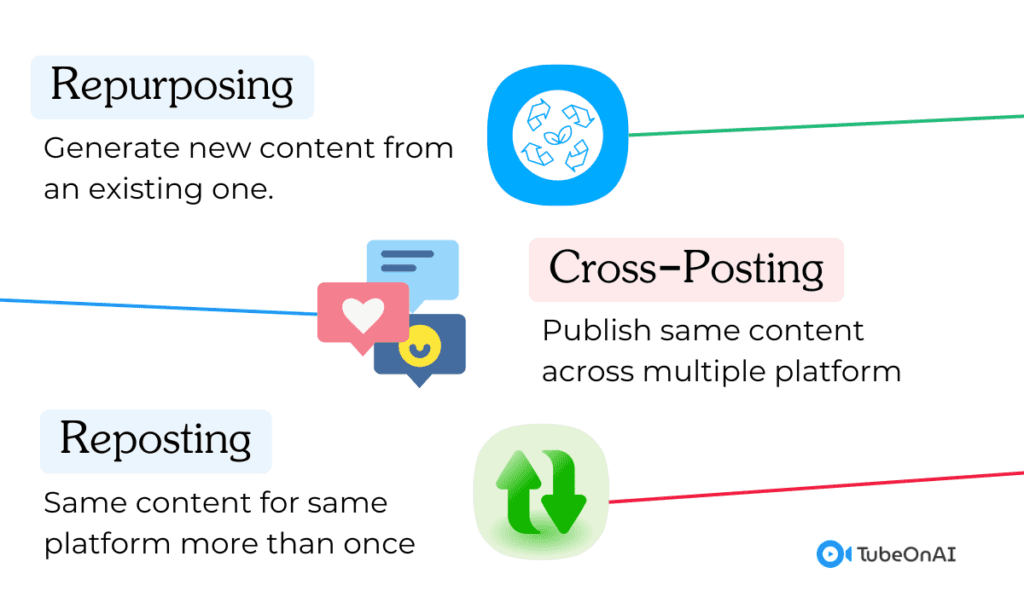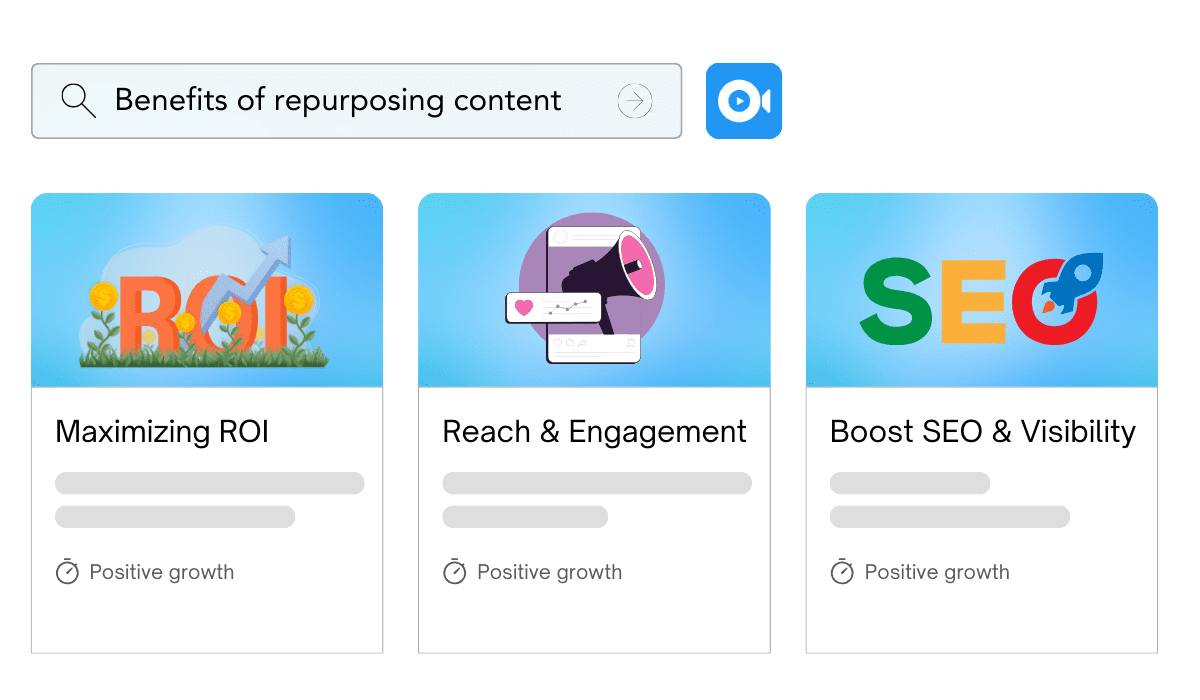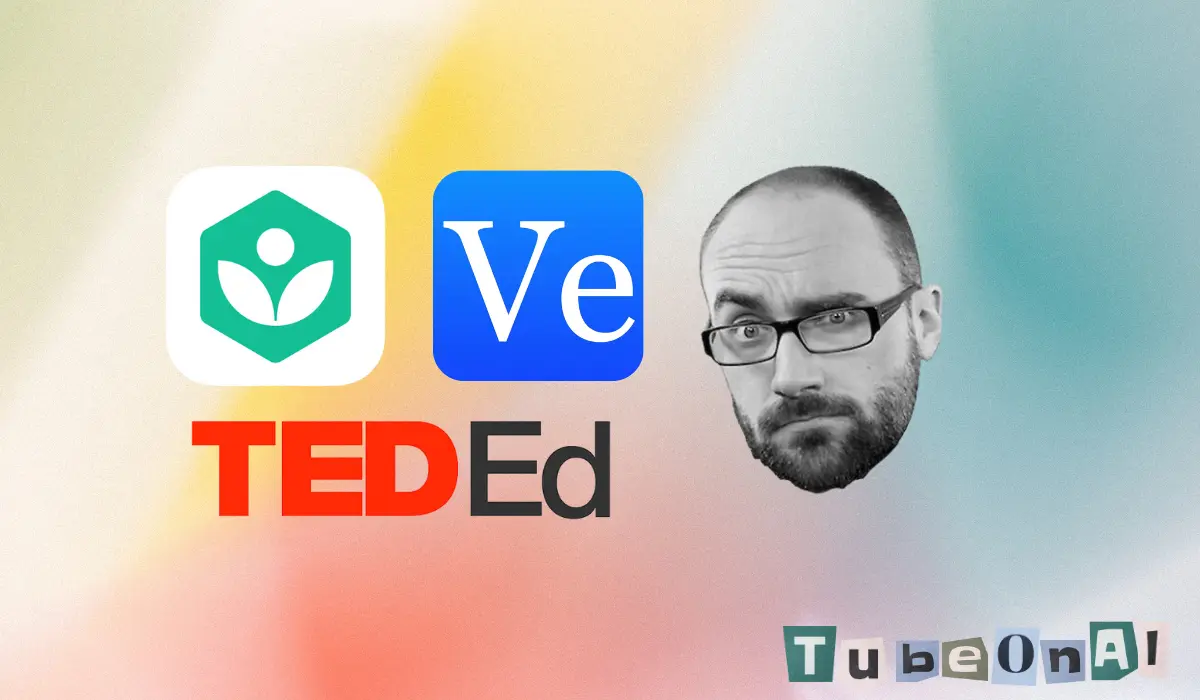Ever wondered how some content creators produce endless posts, videos, and articles across multiple platforms? If you pay attention, you’ll realize: they might be repurposing content. It is the process of turning existing material into something new to save time and reach more people.
But here’s the big question: is it legal?
The short answer is yes – if done correctly.
You must keep in mind several factors here such as copyright laws – which means you can’t simply copy and paste others’ work and repurpose them as your own.
You need to add your own value, give proper credit, and ensure you’re not violating any terms of use.
We will dive deep into these details and provide expert tips on how you can repurpose other people’s content – without crossing the line!

What is the Difference Between Repurpose and Reuse?
When we talk about content, “repurposing” and “reusing” might seem similar, but they mean different things.
Reusing content means taking something that already exists and sharing it again in its original form. For example, sharing a link to an old blog post on social media is a reuse.
You’re not changing anything here. You’re just giving it a second chance to be seen.
On the other hand, repurposing content involves transforming it into a new format or style. This could mean turning a blog post into a podcast episode, creating an infographic from a research paper, or compiling quotes into a social media carousel.
Repurposing adds value because you’re presenting the same information in a new way.
Understanding the difference allows you to better decide how to utilize existing content. Reusing is good for refreshing your content, and repurposing can help you reach new people and keep things exciting.

Repurpose Content Examples
There are several creative ways to repurpose content. Here are some effective examples to get you started:
Blog Posts to Videos
Have a popular blog post? Try making a video version of it! It’s a simple task if you choose the right tool. Leverage the powerful AI application TubeOnAI.
Summarize any content, use the video script AI prompt and you get a script in seconds! Now create the video and share it on different social media platforms like YouTube, Instagram, or Facebook. This way, you can reach those audience who prefer watching over reading.
Videos into Blog Posts or Scripts
Another great way to repurpose content is by turning videos into blog posts. If you have a video packed with useful information, you can easily transcribe it into a detailed blog post.
You can also create scripts from your videos. For example, you have a popular video series. Now, you can repurpose the content by writing a script to use in podcasts, presentations, or other formats.
Podcasts from Articles
You can repurpose written articles or blog posts into podcast episodes. Read the article aloud or discuss it with a guest to create a more engaging audio experience.
Also, you may try to turn a podcast into a blog post. Popular tools like TubeOnAI, Descript, ChatGPT, etc., can help a lot with that effectively.
Infographics from Data
If you have data-heavy content, consider creating an infographic. Infographics are visually appealing and can make complex information easier to understand. You can share these on different platforms or even pitch them to other blogs.
Social Media Posts from Long-Form Content
You can creative ways to repurp, Facebook, and Twitter from existing blog posts, videos, and so on. Break down your long articles or reports into bite-sized pieces to post for these social media platforms.
Using tools like Tubeonai, you can create quotes, tips, or key takeaways and share them regularly. Just input the content, request a summary, and extract key features.
Save time and effort without reading the full content – get the details you need quickly and share them directly.
E-books from Blog Series
E-books are highly in demand today! So, if you have a series of blog posts on a similar topic, you can compile them into an e-book. This can serve as a lead magnet to grow your email list or simply provide your audience with valuable information in one place.
Webinars from Written Content
If you have expertise in a particular area, consider hosting a webinar based on your written content. This way, you can interact with your audience in real time, answer questions, and dive deeper into the topic.
How To Repurpose Other People’s Content Safely
Repurposing other people’s content can be a great way to create something new. To repurpose content created by others, doing it safely and ethically is crucial. Here’s how you can do it:
Get Permission
Before you use someone else’s content, always ask for permission.
This is super important! Many creators love to share their work, especially if you credit them properly. You can simply try sending an email message to them asking for their permission.
Just say something like, “Hi! I enjoyed your article. Would you mind if I turned it into a video?” Most people appreciate being asked.
Use Creative Commons Licenses
Some content is shared under Creative Commons licenses.
This means the creator allows others to use their work under specific rules. You can find this type of content on websites like Flickr or Wikimedia Commons. Always check the license details.
Make sure you know how these things work and how you can use them. For instance, some licenses require you to give credit, while others might not allow changes.
Credit the Original Creator
No matter what, always give credit to the original creator.
When you repurpose their content, it’s nice to mention their name or link back to their website or social media. This not only respects their work but also helps build trust with your audience.
For example, you want to create a video based on a blog. You can give credit by adding something like, “This video is inspired by the blog by [Author’s Name].”
Transform the Content
When you repurpose content, add your own unique touch. Don’t just copy and paste. Instead, transform it into something fresh.
For example, if you have a blog post, consider turning it into a podcast. You can discuss the topic in your own words.
Adding your insights makes it more engaging for your audience. This way, you’re not just repeating what someone else said. You’re creating new value.
Use Tools Like TubeonAI
Using tools can make repurposing content easier. These tools are great for converting the original content into a new form. You can effectively use these tools to repurpose the content examples we’ve mentioned earlier.
One great tool is TubeonAI. It helps you summarize anything from video, podcast, or any web content instantly. With its AI Content feature, you can turn videos or podcasts into blog posts or scripts for content repurposing.
To start, you need to visit the TubeonAI website and create an account. Once you’re signed up, you can access the main dashboard.
Follow Fair Use Guidelines
Familiarize yourself with fair use guidelines. Fair use allows you to use small parts of someone’s content without permission in some cases.
However, it’s a bit tricky. For instance, you might use a short quote from an article or a small clip from a video. Be sure you’re not taking too much.
If you’re ever unsure, it’s best to ask the creator. It’s always better to be safe than sorry!
Always remember that copyright laws protect original content. If you want to use a full piece of someone’s work, you should get their permission first.
Benefits of Repurposing Content
Repurposing content can bring many benefits to your content strategy. Here, we’ve highlighted the major benefits you can get from content repurposing:
Maximizes Content Value
Content repurposing lets you get more mileage out of your (or others’) existing content. Instead of creating something new from scratch, you can transform what you already have into something fresh.
Reaches Different Audiences
Different people prefer different formats. By repurposing, you can reach audiences who might not engage with the original content format. For example, some may prefer videos, while others might enjoy reading blog posts.
Improves SEO
When you repurpose content, you create more opportunities for people to find you online. The more content you have, the more chances you have to rank on search engines.
Saves Time
Creating new content can be time-consuming. Repurposing helps you save time by allowing you to work with what you’ve already created. This means you can focus on other aspects of your business or content strategy.
Enhances Engagement
Different formats can lead to increased engagement. A video might capture attention better than a blog post, leading to more likes, shares, and comments. Engaging your audience in various ways keeps your content fresh and exciting.
Conclusion
Repurposing other people’s content can be valuable when done safely and ethically. You can make the most of existing content by exploring effective examples and following best practices. Not only does it help you save time, but it also allows you to reach new audiences and keep your content strategy fresh. So, the next time you wonder how to repurpose other people’s content, think about how to do it safely. The benefits are so many. Happy repurposing


